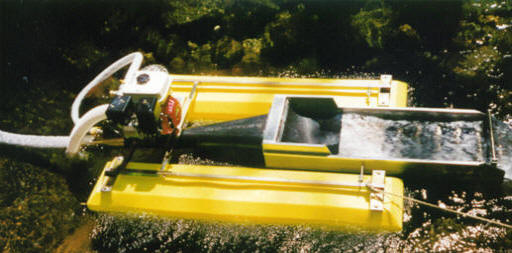How to Dredge for Gold the Right Way

Many a prospector will head out to the rivers and streams with a gold dredge this summer to vacuum some gold up from the depths of the gravel. I was talking to a couple of prospectors in Seattle the other day, they told me they got into a deposit in Slate Creek and took out more than 200 ounces of gold last year and worked the entire summer in one area. The 200 ounces of gold would be worth somewhere in the neighborhood of $200,000, based on some of the nuggets I was shown.
If you are going out dredging this year, let me tell you what sort of equipment the GPAA recommends. A good piece of.equipment to start with would be a 4″ dredge. Now, a lot of individuals make the mistake of buying a small, backpack-type dredge. Unless you have a specific prospecting location in the high mountains or in an area where you must pack in, where a backpack dredge is very good for these applications, you’ll be better off with a larger dredge. A backpack dredge will work an individual almost as hard, if not harder, than will a larger dredge – until you get into the very large sizes of dredges.

The most popular dredge among most dredging prospectors is a 4″ intake with plastic pontoons. If one figures the aggregate size of most gravel in the streams in the Western United States, a 4″ dredge seems to fit the gravel sizes best. The plastic pontoons are preferred over inner tubes because of the problem of getting air into the tubes and the chance of punctures. The plastic pontoons are tough and they give more stability to the dredge which helps in the recovery of the gold.
An undercurrent box in the dredge is good and is preferred by a lot of individuals. Most dredges accomplish this by putting a perforated metal over the first few riffles to classify the material and allow a quiet area for the gold to settle.
The gold dredge has distinct advantages in the you are able to vacuum the material from below the surface of the water in areas to work. With a dredge, you are working down, and that is the way any prospector needs to work. The deeper you go, generally, the more gold you find. A gold dredge is designed so that it digs a hole, and that is not always the case with a #2 shovel.
So, we recommend a 4″ dredge. Most of the major manufactured dredges are fairly similar. I use a Keene 4″ with the new flare tube. This new flare the lows down the water as it goes over the sluice box, thereby allowing for recovery of more fine gold, black sand containing gold and additional concentrates to be worked later.
I also suggest that when you purchase your gold dredge, you get one with a Kooka compressor and that you go ahead and get the reserve tank with air line, regulator, mask and wet suit. Now, I your mend this because your visibility is so much better when you get your head under water. Not that you will be working in deep water to start with, but your visibility is better. You can sec and get a better feel for what is going on.
I recommend that any person who is going to be involved in mining over a long period, and especially young people, should start out with a gold dredge because it gives you such a well rounded education on how the gold was laid in and formed in the rivers and streams. In time the dredger learns to identify bedrock and develops the ability to work out those cracks in the bedrock. The dredger learns how the gold will hide and work its way down into those crevices.
In the operation of your dredge, you will need additional tools such as a pry bar and an under water hammer. A metal detector is good, if you have the funds to buy one,because a metal detector can be used to locate hot spots in the stream. But it is not a necessary piece of equipment to get started. You will need several plastic buckets to bring home your concentrates and a tub to pan in. I often see individuals (especially beginners) make the mistake of taking their concentrates out of the dredge, dumping it into a pan then panning it right back into the river.
Here is a rule of thumb:”Where you find gold is almost always associated with black sand and black sand that the gold is found in generally carries a lot of gold that is invisible to the naked eye. However, where you find black sand does not necessarily mean there is gold present.”
There are many methods of working the gold out of the concentrates. The important thing here is to save the concentrates and remove the gold later. Once panned back into the stream, it is gone and the work process has to start over again.
I have also seen fellows lose gold nuggets panning, so the best tip I can give you, pan from one pan into another, or into a tub. Remove the larger rocks and worthless material, save all the black sand that contains the microscopic gold and take it home for clean up later.
Basically what I do is rough pan my material on the creek, simply to remove the nuggets and to get a gauge on how well I am doing. You won’t always find nuggets. In some areas you can work for flour gold with a gold dredge to good advantage and never find a single nugget. However, a nugget is a very good indicator and it always makes one feel good about the work they are doing.
Environmentally, there are some things that you need to know when you go out with a suction dredge. Dredges are an asset to the fish habitat if used properly. Let me emphasize the “if used properly.” The California Department of Fish and Game has posted dredging seasons so the dredging is done so as not to interfere with the eggs and spawning of the fish in the streams.
We also have general recommended rules in the GPAA that you don’t dredge up into the greenery along t.he side of a stream, that you stay within the wetshed perimeter and that you are careful about moving large boulders and not undercutting trees, etc.
Most of the time you will not find gold in heavy clay layers as the gold will either be on top of the clay layer or underneath it. So the working of these clay layers can cause excessive silting, which in itself is not a problem to fish habitat but is unsightly and could cause problems with the many uneducated, environmental types. 1 don’t mean to be derogatory toward environmentalists but only those who are not enlightened or informed believe that muddy water is polluted water.
If dredging permits are required in your area you must acquire them. You will find a listing pertaining to permits in the GPAA mining guide.
I hope that we have imparted some information that will be helpful to you in the upcoming dredging season. I will be out there on the streams with my wet suit. 1 use a 5″ dredge, but for one just starting out I recommend the 4″. This is a popular size and once you have broken in with the 4″ dredge, they are fairly easy to sell as noted in the classified section of this magazine. I will be working an 8″ dredge up in Alaska this summer and in the fall I will be working my 5″ in the rivers and streams of the Mother Lode of California.
Now here’s one of the letters that we’ve received here at GPAA, and since it’s about dredging I thought I’d run it at the end of this article along with my comments.
Dear George,
Thanks for every issue of the Gold Prospector magazine – they’re packed with interesting and useful information.
George, I have a challenging question related to correct dredging technique and would greatly appreciate a response by you or other GPAA staff plus comments by other experienced members who, hopefully, will read this letter.
Question – What criteria best determines when the dredge riffles and carpet should be “cleaned up,” for greatest efficiency in NOT LOSING GOLD during dredging action?
Specifically, how much of the blue carpet (or miners moss) should remain visible between riffles at all times before a “clean-up” is done and how high (vertically) up each riffle box should black sand and gravel he allowed to build up before a “clean up” is done?
I remember our 1988 Pine Log expedition when the GPAA teams performed the “clean up” of the 5″ dredge only once a week, on Friday aftenoon.
My buddy and I have been doing a “clean up” with each gas refill (approximately one hour of dredging time) and almost always by then there is little or no blue carpet visible because of black sand, gravel and small pebbles. I should add that we use a 2″ backpack Keene dredge with suction-type nozzle.
The only reference book I can find on this question is “The Gold Hunter’s Handbook” by George Sullivan (1981) which state two situations as follows:
Pg. 66 I. “Cleaning the riffles – – the sluice box. If you’re using a sluice box with conventional bar riffles, you should clean out the riffle system whenever that sand accumulates at the bars extends more than halfway up the trough to the next higher bar.”
Pg. 104 Il. “Operating the sluice. Anytime the accumulation of black sand concentrate approaches the midway point between the riffle bars, clean out the riffle system.
So, George, can you please enlighten me, and probably others, with your wisdom and experiences on the subject specifically as it relates to suction dredges?
Best regards,
Lee Royster
Rockville, Maryland
Dear Lee,
I am convinced that most prospectors spend way too much time “cleaning up.” I generally do it when convenient – once per day or week, depending on the size of the dredge and amount of gold. I will check tailing riodically, if any colors show up we have a problem.
Best is to collect concentrates and rough clean for large gold – but don’t clean up so often as to inundate yourself with concentrates. I know this sounds vague, but let common sense prevail, and Good Luck!

